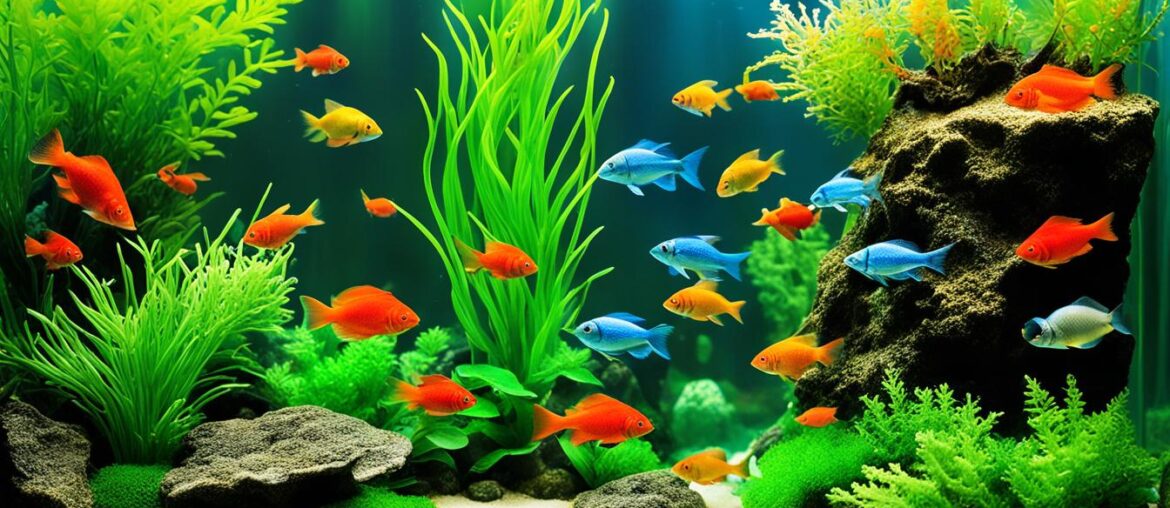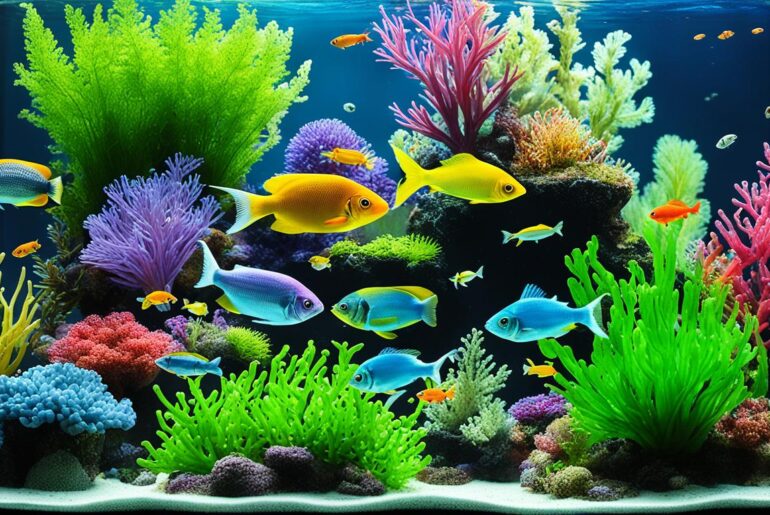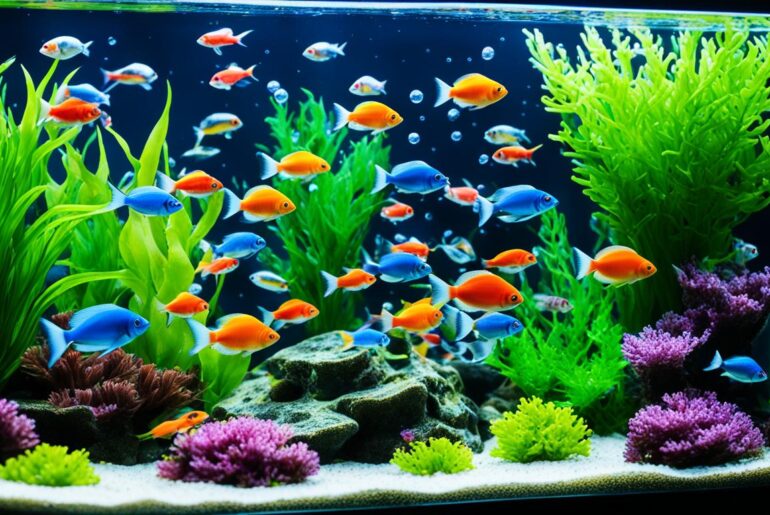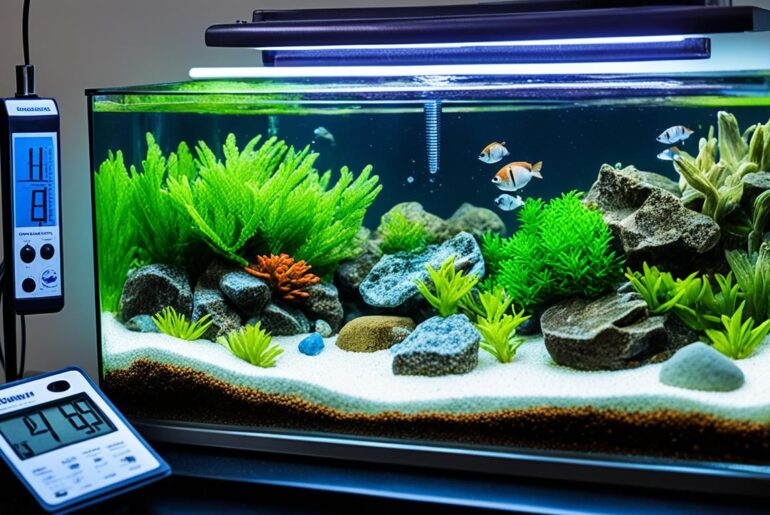Hello, fellow aquarium enthusiasts! As someone who has spent many hours immersed in the world of fishkeeping, I understand the joy and satisfaction that comes from creating a thriving aquatic ecosystem. The mesmerizing beauty of colorful fish gracefully swimming in crystal-clear water is simply unparalleled.
But behind this beauty lies a delicate balance that we must diligently maintain. One crucial factor that often goes unnoticed is the role of temperature in aquarium cycling. Believe me, I have learned this the hard way.
Picture this: a few years ago, I carefully set up my dream aquarium with all the necessary equipment and a vibrant community of fish. Everything seemed perfect, until I noticed a sudden decline in water quality and the health of my beloved aquatic creatures.
I was devastated. Unsure of what went wrong, I sought guidance from fellow hobbyists and did extensive research to uncover the cause of my aquarium troubles. That’s when I discovered the significant impact of temperature on aquarium cycling.
Little did I know that the temperature of my aquarium water played a pivotal role in the cycling process. It directly affected the growth and activity of beneficial bacteria, which are the unsung heroes responsible for converting toxic compounds, such as ammonia, into less harmful substances.
My experience taught me an important lesson: to maximize the effectiveness of aquarium cycling and ensure the well-being of our aquatic friends, we must understand and control the temperature within our fish tanks.
Curious to learn more about the effect of temperature on aquarium cycling? Join me as we delve into the fascinating world of temperature control and its impact on the nitrogen cycle. Together, we’ll unlock the secrets to creating a flourishing aquatic paradise.
Key Takeaways:
- Temperature plays a crucial role in aquarium cycling by influencing the growth and activity of beneficial bacteria.
- Optimal temperature for aquarium cycling typically ranges between 75-82°F (24-28°C).
- Higher temperatures can accelerate the cycling process but may increase the risk of disease outbreaks.
- Lower temperatures slow down bacterial activity but reduce the risk of harmful microorganism growth.
- Maintaining a stable and suitable temperature throughout the cycling process is essential for a healthy and balanced ecosystem.
The Importance of Proper Temperature for Aquarium Cycling
When it comes to aquarium cycling, temperature plays a crucial role in the success of the process. The growth and activity of beneficial bacteria, responsible for converting toxic compounds like ammonia into less harmful substances, are directly influenced by the temperature of the aquarium water. It’s important to understand the impact of temperature on aquarium cycling to ensure the establishment of a healthy and balanced ecosystem.
The optimal temperature range for aquarium cycling generally falls between 75-82°F (24-28°C). Within this range, the beneficial bacteria thrive and work efficiently to break down ammonia and nitrite. However, temperatures outside of this range can affect the cycling process and the overall health of the aquarium.
Higher temperatures can accelerate the cycling process. The increased metabolic rates of both fish and bacteria lead to faster ammonia production and conversion. However, it’s important to note that higher temperatures also create a favorable environment for the growth of harmful microorganisms, increasing the risk of disease outbreaks in the aquarium.
On the other hand, lower temperatures slow down bacterial activity, lengthening the cycling process. While this may extend the time it takes to establish a fully cycled aquarium, lower temperatures also reduce the risk of disease outbreaks, as the slower bacterial activity helps maintain a more stable ecosystem.
Maintaining a stable and suitable temperature throughout the cycling process is crucial. Fluctuations in temperature can stress fish and bacteria, hindering the cycling process and potentially causing harm to the aquatic inhabitants. Regular monitoring of the temperature and making necessary adjustments to keep it within the optimal range is essential.
Pro Tip: Using a reliable aquarium heater and thermometer is highly recommended for maintaining optimal temperature conditions during aquarium cycling. Additionally, providing proper aeration and ensuring the absence of direct sunlight and drafts in the aquarium setup contribute to temperature stability.
The Importance of Temperature Control
Temperature control is a critical aspect of maintaining a healthy aquarium environment during the cycling process. It directly impacts the growth and activity of beneficial bacteria, which ultimately determine the success of the nitrogen cycle. By ensuring a stable and suitable temperature range, you can foster a balanced and thriving aquatic ecosystem.
| Effect | High Temperature | Low Temperature |
|---|---|---|
| Potential Effects on Fish | Increases metabolic rates and ammonia production, risk of harmful microorganism growth | Reduces metabolic rates and bacterial activity, slower cycling process |
| Potential Effects on Bacteria | Accelerates bacterial growth and activity | Slows down bacterial growth and activity |
| Potential Effects on Cycling Time | Shortens cycling time | Prolongs cycling time |
| Risk of Disease Outbreaks | Increased risk due to favorable conditions for harmful microorganisms | Reduced risk due to slower bacterial activity |
By carefully monitoring and maintaining the optimal temperature for aquarium cycling, you can ensure the health and well-being of your fish while establishing a stable and thriving aquarium ecosystem.
Effects of High Temperature on Aquarium Cycling
High temperatures can have both positive and negative effects on the aquarium cycling process. Let’s explore how temperature impacts fish tank cycling and the nitrogen cycle in aquariums.
When the temperature in the aquarium is on the higher side, it can accelerate the cycling process by promoting the growth and activity of beneficial bacteria. This is because warmer temperatures increase the metabolic rates of these bacteria, allowing them to process toxic compounds like ammonia more efficiently.
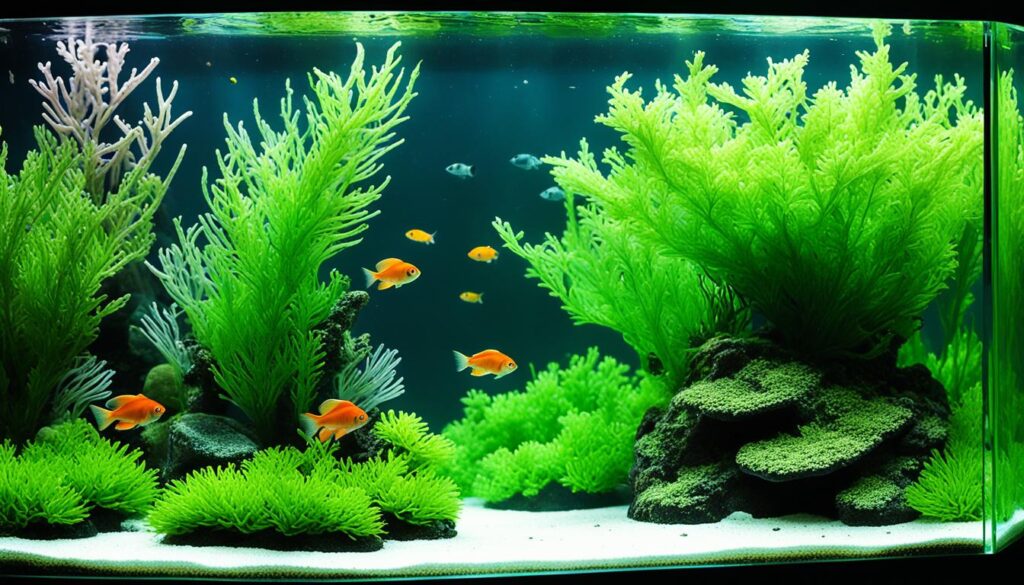
However, it is important to note that excessively high temperatures can also have negative consequences. Fish have higher metabolic rates in warm water, which can lead to increased ammonia production. This can be harmful to the fish and can potentially result in toxicity. Therefore, it is crucial to closely monitor water parameters, such as ammonia levels, and ensure adequate aeration and filtration to prevent any adverse effects.
In order to maintain a suitable temperature and mitigate the risks associated with high temperatures, consider the following tips:
- Regularly monitor the water temperature using a reliable thermometer.
- Ensure proper filtration and aeration to maintain optimal oxygen levels.
- Consider using cooling devices, such as fans or chillers, if necessary.
By taking these precautions and effectively managing the temperature in your aquarium, you can optimize the cycling process and create a healthy environment for your fish.
Effects of Low Temperature on Aquarium Cycling
When it comes to aquarium cycling, temperature plays a significant role in the growth and activity of beneficial bacteria. Low temperatures can have both positive and negative effects on the cycling process.
Slowing Down Bacterial Growth:
Lower temperatures slow down the growth and activity of beneficial bacteria involved in the nitrogen cycle. While this may prolong the cycling process, it also reduces the risk of harmful microorganism growth. The slower bacterial activity leads to lower ammonia production, creating a safer environment for the fish and other inhabitants of your aquarium.
Fish and Bacterial Metabolic Rates:
In aquariums with lower temperatures, both fish and bacterial metabolic rates are reduced. As a result, fish produce less ammonia, minimizing the toxicity levels in the water. However, the slower bacterial activity may also result in a slower cycling process overall.
Maintaining an appropriate temperature range is crucial to avoid detrimental effects on the cycling process. Ensure that you choose an optimal temperature for your specific aquarium setup, taking into consideration the types of fish and plants you have. By maintaining a suitable temperature, you can strike a balance between the cycling process and the overall health of your aquatic ecosystem.
| Effects of Low Temperature on Aquarium Cycling | Summary |
|---|---|
| Slows down the growth and activity of beneficial bacteria | Prolongs the cycling process |
| Reduces the risk of harmful microorganism growth | Creates a safer environment for fish |
| Reduces fish and bacterial metabolic rates | Decreases ammonia production |
| – | Slows down the overall cycling process |
Maintaining Optimal Temperature During Aquarium Cycling
To ensure successful aquarium cycling, it is essential to maintain the optimal temperature throughout the process. The temperature directly influences the growth and activity of beneficial bacteria responsible for the nitrogen cycle. By carefully controlling the temperature, you can create an environment conducive to the development of a healthy and balanced ecosystem.
One of the key tools in maintaining the right temperature is a reliable and accurate aquarium heater. Choose a heater that suits the size of your aquarium and set it to the desired temperature range. Regularly monitoring the water temperature using a thermometer will help you ensure that it stays within the appropriate range.
Adequate aeration is another crucial factor in temperature control during aquarium cycling. Providing sufficient oxygen levels in the water is vital for the well-being of fish and beneficial bacteria. Consider using an air pump or other aeration devices to maintain optimal oxygen levels within the aquarium.
In some cases, additional equipment such as fans or chillers may be necessary to maintain the desired temperature range. Fans can help dissipate excess heat, while chillers can lower the temperature if it becomes too high. Assess the specific needs of your aquarium and invest in the necessary equipment to maintain a stable and suitable temperature.
Remember, maintaining optimal temperature during aquarium cycling is essential for the growth and activity of beneficial bacteria. By providing a stable and comfortable environment, you enhance the chances of a successful and healthy nitrogen cycle.
Recommended Temperature Ranges for Aquarium Cycling
| Fish Species | Optimal Temperature Range (°F) | Optimal Temperature Range (°C) |
|---|---|---|
| Tropical Freshwater Fish | 75-82°F | 24-28°C |
| Marine Fish | 77-80°F | 25-27°C |
| Coldwater Fish | 60-70°F | 15-21°C |
Refer to the table above for the recommended temperature ranges for different types of fish commonly used in aquariums. These ranges provide a general guideline, but it is always important to research the specific temperature requirements of the fish species in your aquarium.
By maintaining optimal temperature conditions during aquarium cycling, you create an environment that promotes the growth of beneficial bacteria and supports the health and well-being of your fish. Consistent monitoring and temperature adjustments, along with the use of appropriate temperature control equipment, are key to achieving a successful and thriving aquatic ecosystem.
Common Challenges in Temperature Control During Aquarium Cycling
During the process of aquarium cycling, maintaining a consistent temperature can pose some challenges. Fluctuations in temperature can occur due to various factors such as changes in room temperature or inadequate temperature control equipment. These rapid temperature changes can have a negative impact on both fish and beneficial bacteria, ultimately affecting the effectiveness of the cycling process.
To overcome these challenges and ensure optimal temperature control during aquarium cycling, here are some important steps to follow:
- Regular temperature monitoring: It is crucial to regularly monitor the temperature of your aquarium to track any fluctuations. This can be done using a reliable aquarium thermometer. By keeping a close eye on the temperature, you can promptly identify any deviations and make necessary adjustments to maintain the desired range.
- Adjustments as needed: If you notice any significant changes in temperature, it is vital to take immediate action. Adjust the temperature control equipment, such as aquarium heaters or chillers, to maintain the desired temperature range for cycling. Consult the user manual of your equipment for detailed instructions on proper adjustment.
- Stable environment: Ensure that your aquarium is placed in a stable environment, away from direct sunlight or drafts. These external factors can contribute to temperature fluctuations. Consider locating your aquarium in a suitable area where the room temperature remains relatively stable.
By following these steps, you can effectively address common challenges in temperature control during aquarium cycling. Maintaining a stable and suitable temperature is crucial for the health of your fish and the activity of beneficial bacteria, ultimately leading to a successful and balanced cycling process.
To visually demonstrate the impact of temperature on aquarium cycling, refer to the table below:
| Temperature Range (°F) | Effect on Aquarium Cycling |
|---|---|
| 75-82 | Optimal temperature range for aquarium cycling, promotes growth and activity of beneficial bacteria |
| Above 82 | Accelerates cycling process but may increase the risk of harmful microorganism growth |
| Below 75 | Slows down bacterial activity, extends cycling process, reduces risk of disease outbreaks |
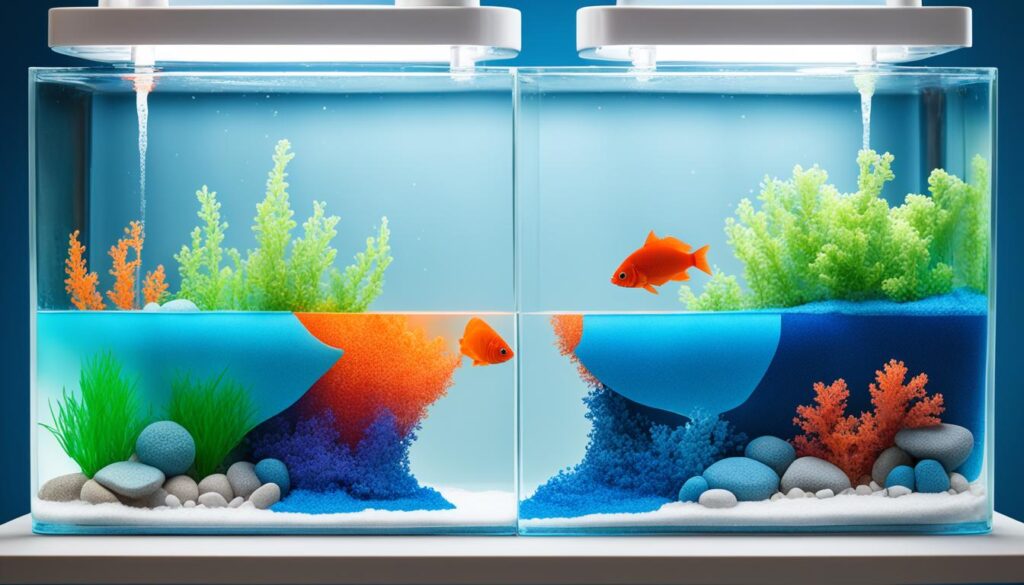
A table illustrating the effects of different temperature ranges on the aquarium cycling process. Maintaining an optimal temperature range is essential for successful aquarium cycling.
Temperature and Fish-in Cycling
Fish-in cycling is a method of cycling an aquarium while fish are present. This process can be affected by temperature fluctuations, making it essential to maintain a stable and suitable temperature throughout the cycling process. By doing so, we can minimize stress on the fish and ensure their health and well-being.
To create an optimal environment for both fish and the beneficial bacteria involved in the cycling process, regular monitoring and temperature adjustments are necessary. This ensures that the temperature remains within the ideal range, promoting the growth and activity of the bacteria while keeping the fish comfortable.
By maintaining stable and appropriate temperatures, we can minimize potential stressors on the fish and support the establishment of a healthy and balanced ecosystem in the aquarium. Monitoring the temperature closely and making necessary adjustments will help to maintain an optimal environment for both fish and bacteria.
Benefits of Proper Temperature Control during Fish-in Cycling
Proper temperature control during fish-in cycling offers several benefits, including:
- Promoting the growth and activity of beneficial bacteria
- Minimizing stress on fish
- Reducing the risk of disease outbreaks
- Supporting overall fish health and well-being
“Maintaining a stable and suitable temperature during fish-in cycling is crucial for the health and well-being of the fish, as well as the success of the cycling process.”
By implementing effective temperature control measures, we can ensure a smoother and more successful fish-in cycling experience. This allows for the establishment of a thriving aquarium ecosystem while providing a comfortable and healthy environment for our fish.
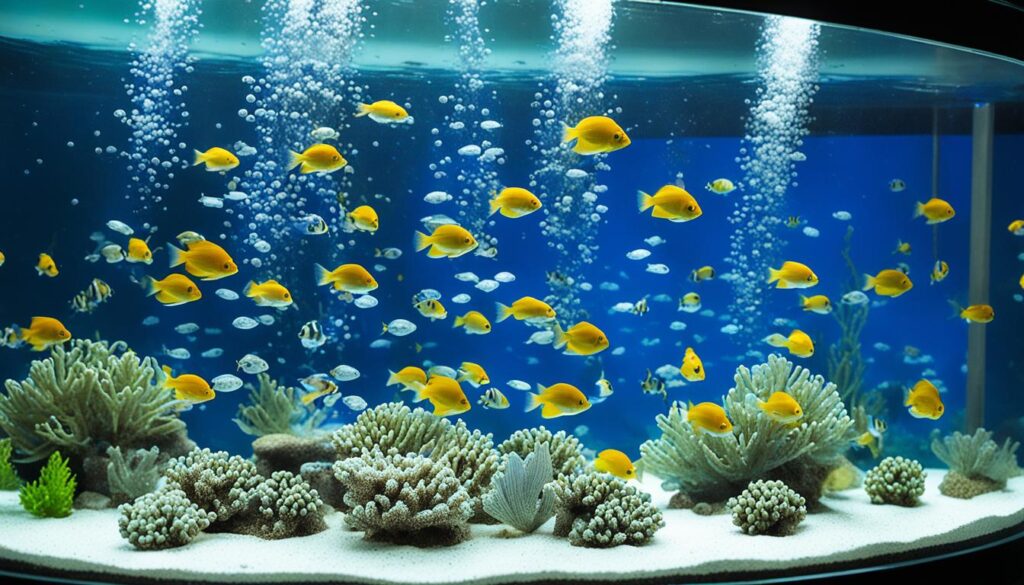
The Role of Temperature in Fish Health and Cycling Success
When it comes to the health and success of fish in an aquarium, temperature plays a crucial role. Maintaining the optimal temperature range is essential for achieving successful aquarium cycling and creating a healthy aquatic ecosystem.
First and foremost, temperature impacts the growth of beneficial bacteria that are responsible for establishing a stable nitrogen cycle in the aquarium. These bacteria play a vital role in converting toxic compounds, such as ammonia, into less harmful substances. By maintaining the appropriate temperature conditions, we provide the ideal environment for these bacteria to thrive and perform their crucial task effectively.
Additionally, temperature has a direct influence on the metabolic rates of fish. Optimal temperatures facilitate a healthy metabolic activity in fish, promoting their overall well-being and immune response. On the other hand, extreme temperatures can lead to stress and health issues for fish, compromising their ability to adapt and thrive in the aquarium environment.
By understanding the influence of temperature on fish health and cycling success, we can take the necessary steps to ensure optimal temperature control in our aquariums. Regular monitoring, the use of reliable temperature control equipment, and creating a stable environment are all crucial factors in maintaining the ideal temperature range.
To illustrate the impact of temperature on fish health and cycling success, let’s take a look at the following comparison table:
| Temperature Range | Effect on Fish Health | Effect on Cycling Success |
|---|---|---|
| Too high | Increased stress and risk of disease | Accelerated bacterial activity, but potential for higher ammonia production |
| Optimal | Promotes healthy metabolic rates and immune response | Supports the growth and activity of beneficial bacteria |
| Too low | Reduced metabolic activity and compromised immune response | Slowed bacterial activity, prolonging the cycling process |
It is evident from the table that maintaining the optimal temperature range is crucial for both fish health and cycling success. By ensuring that our aquariums are within the ideal temperature range, we provide the best possible environment for our fish to thrive and for the nitrogen cycle to establish effectively.
In summary, temperature plays a significant role in fish health and cycling success. Optimal temperature conditions promote the growth of beneficial bacteria and help establish a stable nitrogen cycle. Additionally, temperature affects the metabolic rates of fish, impacting their overall health and immune response. By maintaining the appropriate temperature range, we can achieve successful aquarium cycling and create a healthy aquatic ecosystem.
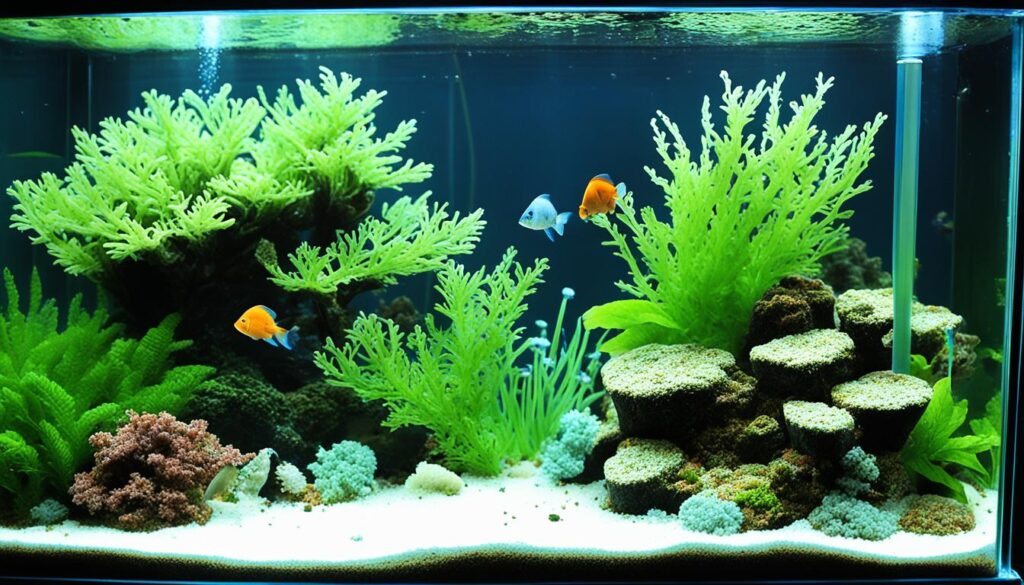
Quote:
“Maintaining the optimal temperature range is essential for achieving successful aquarium cycling and creating a healthy aquatic ecosystem.”
Conclusion
In conclusion, the temperature of an aquarium is a critical factor in the cycling process. It directly influences the growth and activity of beneficial bacteria responsible for converting toxic compounds into less harmful substances. To maximize the effectiveness of aquarium cycling, it is essential to maintain the optimal temperature range throughout the process.
By controlling the temperature, you can ensure the establishment of a healthy and balanced aquatic ecosystem. Regular monitoring and adjustments, combined with the use of suitable temperature control equipment, are key to achieving successful aquarium cycling and ensuring the well-being of your fish.
Remember, maintaining a stable and appropriate temperature helps promote the growth of beneficial bacteria and supports fish health. So, whether you are embarking on aquarium cycling or managing an established tank, temperature control should always be a priority. By understanding and managing the impact of temperature, you can create an optimal environment for both your aquatic inhabitants and the overall cycling process.
FAQ
How does temperature affect aquarium cycling?
The temperature of the aquarium water directly affects the growth and activity of beneficial bacteria involved in the nitrogen cycle. It plays a crucial role in the cycling process.
What is the ideal temperature range for aquarium cycling?
The ideal temperatures for aquarium cycling typically range between 75-82°F (24-28°C).
How does high temperature impact aquarium cycling?
High temperatures can accelerate the cycling process, but they may also increase the risk of harmful microorganism growth and elevated ammonia levels.
What happens if the temperature is too low during aquarium cycling?
Low temperatures slow down the growth and activity of beneficial bacteria involved in the nitrogen cycle, prolonging the cycling process. However, it reduces the risk of harmful microorganism growth.
How can I maintain optimal temperature during aquarium cycling?
To maintain optimal temperature, use a reliable aquarium heater and set it to the desired temperature range. Regularly monitor the water temperature with a thermometer and provide adequate aeration to ensure sufficient oxygen levels.
What are the common challenges in temperature control during aquarium cycling?
Common challenges include temperature fluctuations due to changes in room temperature and inadequate temperature control equipment. It is important to monitor the temperature regularly and make adjustments as needed.
Does temperature affect fish-in cycling?
Yes, maintaining a stable and suitable temperature is crucial for minimizing stress on the fish and ensuring their health during the cycling process.
How does temperature influence fish health and cycling success?
Temperature affects the metabolic rates of fish and the overall health and immune response, ultimately impacting the success of aquarium cycling and the well-being of the fish.
